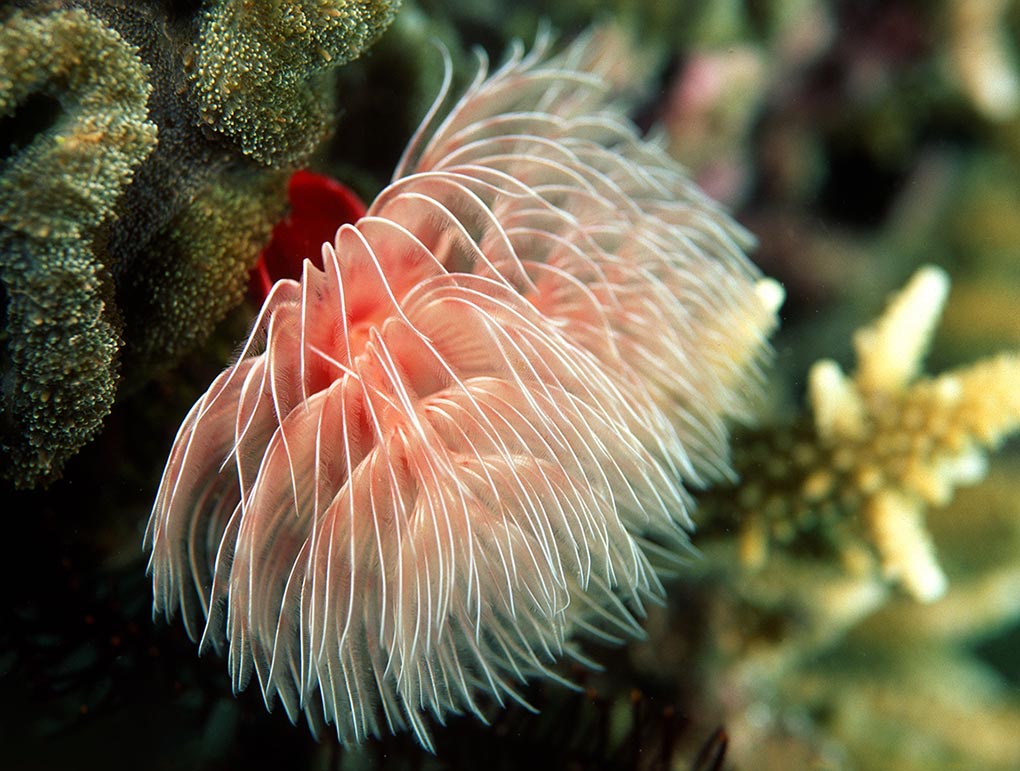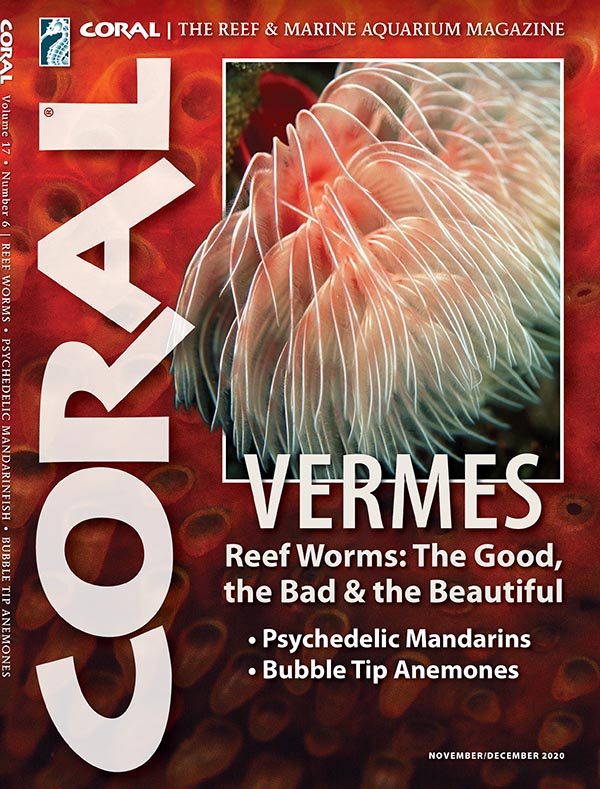
Magnificent Feather Duster or Coco Worm
This large serpulid feather-duster has a hard, calcareous tube that can reach about 1 cm in diameter. One characteristic of worms in the genus Protula is that, unlike most serpulids, they lack an operculum to close the tube. The “feathers” form a double spiral, which can vary from almost pure white to almost cherry red. It does not burrow into coral heads, rather it secretes its tube on them. It has been reported to commonly be found between two live coral heads. This tube worm is commonly seen for sale in the hobby, but like most feather dusters, it requires a lot of very fine particulate material suspended in the water to feed upon, hence it has poor survival in many reef tanks, the water is too clean.
Marine worms worth knowing—A survey of the Good, the Bad, and the Beautiful
images by Denise Nielsen Tackett and Larry P. Tackett
CORAL staff report with Dr. Ronald L. Shimek
A partial excerpt from the November/December 2020 issue of CORAL Magazine. Subscribers can log in to read the entire article in the digital edition.
The earliest taxonomists, Carl Linneaus and Jean-Baptiste Lamarck, called them Vermes, and we continue to use the term “worms” today for more-or-less soft-bodied animals that lack limbs and have an elongate, slithering, crawling, or burrowing body. Bait fishermen and robins may love a juicy nightcrawler, but “worm” is a term with many negative associations—the most wretched of human beings and the most malicious of software viruses are called worms.
Vermes is now obsolete as a formal classification, but the label “worms” is commonly used by taxonomists as a vernacular, descriptive name. A vermiform body can be considered the default body form for virtually all animals, particularly given the various wormy larvae, such as the amphiblastula and planula found in sponges and cnidarians, respectively. Using “worm” as a valid descriptive term is illustrated in the accompanying chart and portfolio of images.
Just how many species of worms are there in the seas? An anonymous author of an ambitious survey of Animal Phyla for Wikipedia threw up his or her hands and said, perhaps with a gasp, “Total numbers are estimates; figures from different authors vary wildly, not least because some are based on described species, and some are based on extrapolations to numbers of undescribed species. For instance, around 25,000 to 27,000 species of nematodes have been described, while published estimates of the total number of nematode species include 10,000 to 20,000; 500,000; 10 million; and 100 million.”
For the aquarist, there is one truth: If you have a functioning, reasonably healthy marine aquarium, you have worms. Some we welcome and marvel at: the various feather dusters and Christmas Tree worms. Others may be intentionally introduced as “clean-up crew”—the prime example being so-called Spaghetti Worms. Others are uninvited guests that arrive on rock, sand, corals, clam shells, and even via fishes.
To repeat: you are a wormkeeper, like it or not (probably for more worms than you ever imagined). If nature abhors a vacuum, she positively gushes about worms! The many different animals we call worms love a warm, nutrient-rich environment with countless hiding places and surfaces to colonize. While some of these can be troublesome (see Reef Flatworms, page 48), the vast majority are detritivores and are generally beneficial and harmless members of a micro-biotope. Many, in fact, provide live feeding opportunities for reef fishes and motile invertebrates.
“WORMS” PHYLA
Worm-like animals are found in many different animal phyla. Those listed here have some or all species found in marine and brackish environments. These groups account for an estimated 75,000 known different worm-type animals by some counts. (Other taxonomists believe the actual number, including yet-to-be-discovered species, may be in the millions or hundreds of millions.) Many appear in marine aquaria, often arriving as hitchhikers or accidental introductions. A few can present problems, but most are harmless or beneficial and the sign of a healthy captive biotope.
ANNELIDA
Annelids
Segmented worms, earthworms, marine polychaetes (bristle worms, fireworms, featherduster worms, spaghetti worms, cirratulid worms), tongue worms, bobbit worms
17,000+ species
CHAETOGNATHA
Chaetognaths
Arrow worms
(predatory marine worms)
100 species
ENTOPROCTA
Goblet Worms
150 species
GASTROTRICHA
Gastrotrich Worms
690 species
GNASTOMULIDA
Jaw Worms
100 species
NEMATODA
Nematodes
Roundworms
25,000 species
NEMERTEA
Nemertean Worms
Ribbon, proboscis,
bootlace worms
1,200 species
PHORONIDA
Horseshoe Worms/Phoronids
11 species
PLATYHELMINTHES
Flatworms
Cestodes, tapeworms
29,500 species
PRIAPULIDA
Priapulid Worms
Penis worms
20 species
SIPUNCULA
Peanut Worms
Est. 144–320 species
XENACOELOMORPHA
Acoels (Aceol Flatworms) Xenoturbellids
400+ species
Read More
Read the full article in the November/December 2020 issue of CORAL Magazine, including numerous examples of the “VERMES” one might encounter in their home reef aquaria. All subscribers can log in to the digital edition to read now!
Sources
Shimek, Ronald L. (2004). A PocketExpert Guide: Marine Invertebrates. pp: 204-226. Microcosm/TFH.
Wikipedia: Phylum – Animals
https://en.wikipedia.org/wiki/Phylum#Animals
Additional Online Reading


